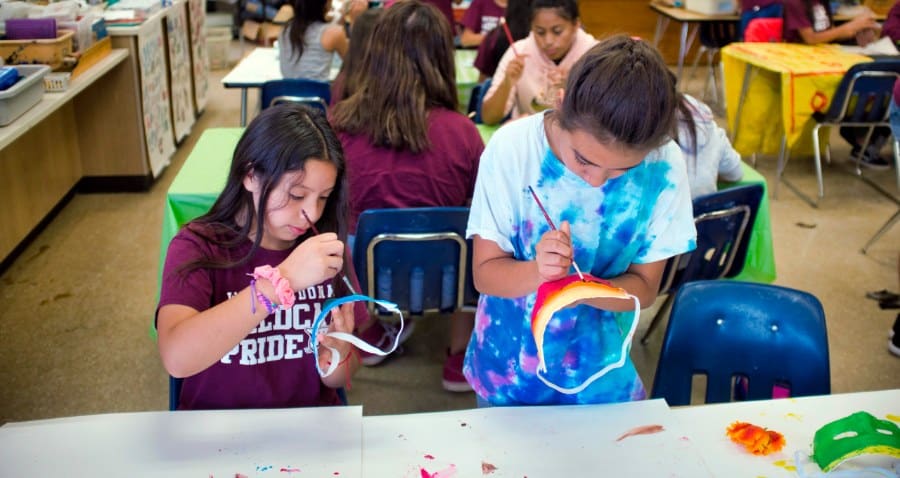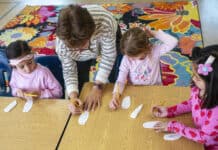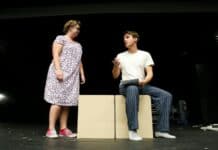Sponsored and funded by the city of Sedona since 1989, the Artists in the Classroom program enhances learning experiences for children, introducing artists into their regular class curriculum with drawing, painting, music, dance, theater and poetry.
“There are a lot of different ways that we can integrate it,” said Nancy Lattanzi, arts and culture coordinator for the city of Sedona. “It makes learning easier and more fun. They can experience more and remember it more when you integrate the arts into it.”
An example of the artistic diversity of the program took place this month at West Sedona School. Shalimar Rodgers’ sixth-grade class learned about ancient civilizations by making their own masks, molded over their faces and then painted by them to portray certain roles in a Stone-Age community.
“I wanted the students to show the evolution of the Stone Age, based on the Paleolithic lifestyles, the hunter-gatherer, the cave painters, the tool makers,” Rodgers said.
Pash Galbavy, a mask-making artist, helped the students to connect creation of masks with the roles performed in a Stone-Age culture. “My thought was that this would take it out of the mental level and bring the study into more of a visual format,” Galbavy said. “So hopefully they would enjoy it more and it would be a more engaging experience and more of an impact on the learning experience.”
Nancy Lattanzi says studies have shown that integrating art in the classroom stimulates problem solving, develops critical thinking and refines cognitive and sensory skills, adding to the overall academic success of the students.
“That’s exactly the idea, to mix and match, so you have your mental component and you bring that into the creative arts and activate a different, more creative part of your brain and hopefully that will have more of a lasting, enjoyable impact,” Galbavy said.
Creating the masks worked out well for students as it helped them “wear” the role of a past civilization.
“It was fun,” sixth-grader Jason Garcia said. “I learned about the Stone Age, how they lived thousands of years back, how they have to hunt, to work together.”
“I feel like I was there, many thousand years ago,” sixth-grader Alasandra Oestmann said. “We were pretending to paint … my role was cave art.”
“My delight is in the masks and just how well they came out to represent each of those roles of the Stone Age,” Rodgers said. “I was so excited at what the students did and showing they’re learning through that, knowing they had to have a certain style of tool to understand the toolmaker, to understand the cave art. It was definitely hands-on. Kids remember something that they’ve created.”
Lattanzi has 14 new artists added to the program this year for a total of 30 artists. Last year Deb Sanders’ WSS Advanced Placement English class visited seniors at Sedona Winds retirement home. Their assignment was to interview them, write poetry about their lives and return to visit with bound books of pictures and poetry.
“They went back and performed the poems with images of their lives,” Lattanzi said. “It brought such joy to the seniors to have their stories told. They’re [students] learning English and poetry, and they’re learning to express themselves in a moving experience they will never forget.”
All those involved agree the Artist in the Classroom program has been an unqualified success.
“I feel like it’s a gift to be able to have a city that supports the arts in this way. There is a huge amount of artists that live in this town,” Lattanzi said. “The fact that there are galleries everywhere and we were able to reach out to the schools is a rare thing.”
“The Arts in the Classroom is really a tremendous boon to the community,” Galbavy said. “You can bring all kinds of artists into the classroom and kids can sample all kinds of art forms with different artists.
“It’s an invaluable asset to the school because students who might not grasp information from traditional learning remember things that they’ve created that have a connection to the curriculum,” Rodgers said. “Having this here in Sedona, having the expertise of different methods of art is phenomenal.”
Don Eicher can be reached at 282-7795 ext 126 or by email at deicher@larsonnewspapers.com






















